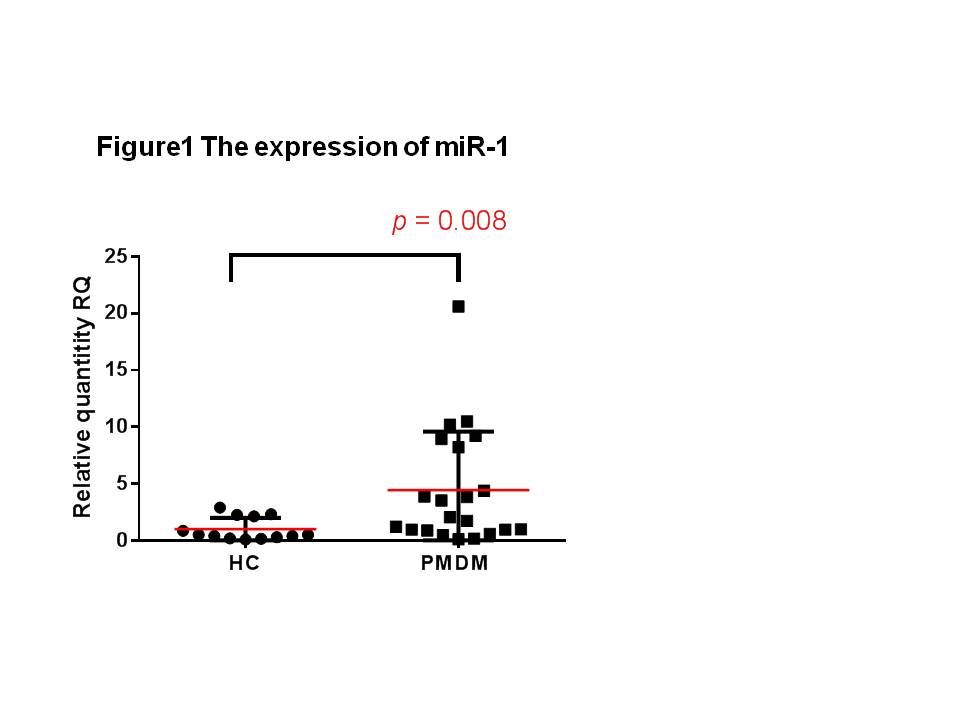Session Information
Session Type: ACR Poster Session C
Session Time: 9:00AM-11:00AM
Background/Purpose: Although intensive immunosuppressive treatment are necessary for the severe cases with polymyositis (PM)/dermatomyositis (DM), the prognostic factors or disease activity indices for PM/DM have not established yet. On the other hand, microRNAs are small non-coding RNAs, some of which have a certain function such as a transcriptional regulation. MicroRNA-1 (miR-1) has been shown to be associated with myocyte differentiation, decreased in muscle biopsy sample from patients with inflammatory myopathies, and induced by type I interferon. Here we investigated the association between serum miR-1 level and clinical course of PM/DM patients.
Methods: We retrospectively analyzed clinical features, and laboratory data at baseline in patients with PM/DM patients who had received initial treatment at Yokohama City University Hospital from 2008 to 2017. We also investigated initial therapeutic regimens, clinical outcomes, and episodes of serious infection The serum samples from PM/DM were collected before and after starting treatment and those from healthy controls were recruited from the biobank institution in the hospital. The serum miR-1 levels were measured by quantitative real-time PCR.
Results: Twenty-two patients (PM 4, DM 11, clinically amyopathic DM (CADM) 7) were recruited. The mean age was 63.5 ± 8.5 years, 13 (59%) were female, and 14 patients (64%) had interstitial lung disease. Among the patients, 3 patients died and 9 had infections which needed antibiotic therapy within 6 months from diagnosis. The serum miR-1 level was significantly elevated in PM /DM patients as compared to healthy control (p = 0.008; Figure 1). In PM/DM patients, the serum miR-1 level was significantly decreased by treatment (p = 0.03). There was a correlation between serum CK and miR-1 levels in PM/DM patients (p = 0.005, r = 0.58), although there was no correlation between the improvement rate of serum CK and miR-1 levels in PM/DM patients. We identified the cutoff value of serum miR-1 level from the two standard deviations in healthy controls, and divided all the PM/DM patients or PM/DM patients with interstitial lung disease (PM/DM-ILD) into two groups by the serum miR-1 level at baseline, respectively. There were no significant differences in clinical data, outcomes, and treatment regimens in PM/DM patients. However, in the PM/DM-ILD patients, although there was no significant differences in clinical data at baseline and the initial dose of prednisolone (PSL), the higher miR-1 group needed longer time to be tapered to the half of initial PSL dose (p = 0.021) as compared to lower miR-1 group. The higher miR-1 group also tended to be complicated by infection within 6 months from starting treatment more frequently (p = 0.008).
Conclusion: This is the first report showing the elevated serum miR-1 level in PM/DM patients. miR-1 can be a predictive marker for response to immunosuppressive therapy for PM/DM-ILD.
To cite this abstract in AMA style:
Sugiyama Y, Yoshimi R, Kunishita Y, Kishimoto D, Kirino Y, Nakajima H. Serum Microrna-1 Can be a Predictive Marker for Disease Activity of Polymyositis/Dermatomyositis-Associated Interstitial Lung Disease [abstract]. Arthritis Rheumatol. 2017; 69 (suppl 10). https://acrabstracts.org/abstract/serum-microrna-1-can-be-a-predictive-marker-for-disease-activity-of-polymyositisdermatomyositis-associated-interstitial-lung-disease/. Accessed .« Back to 2017 ACR/ARHP Annual Meeting
ACR Meeting Abstracts - https://acrabstracts.org/abstract/serum-microrna-1-can-be-a-predictive-marker-for-disease-activity-of-polymyositisdermatomyositis-associated-interstitial-lung-disease/
